Flash Primer 4 - High Speed Flash Photography
Photography and Text Copyright Joe McDonald. All rights reserved.
Using only natural light, high shutter speeds are not sufficiently fast enough to capture extremely fast action. Moreover, when coupled with relatively slow but fine grain films, fast shutter speeds require wide apertures that result in minimal
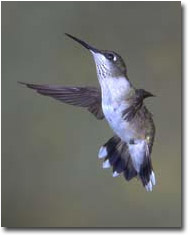 depth of field. Using electronic flash solves both problems, allowing you to capture extremely fast action while enjoying great depths of field.
depth of field. Using electronic flash solves both problems, allowing you to capture extremely fast action while enjoying great depths of field.
In previous columns, I discussed the problems inherent with high-speed flash. Although brief flash durations are possible with many flash units with variable power ratios, it is at the cost of a low Guide Number that requires fairly close flash-to-subject distances.
For example, with my Canon 550EX flash my GNs are 40 for 1/4 power, 28 for 1/8 power, 20 for 1/16 power, and 14 for 1/32 power. (These GNís differ from Canonís by about one stop, which is typical for most units. Manufacturers almost always rate a flash higher than actual shooting conditions permit.) Letís say I was using 1/8th power to obtain a relatively fast flash duration, between 1/4,000th and 1/8,000th sec., and my flash to subject distance was 5 feet. I canít state the exact flash duration because Canon, like most manufacturers today, does not publish the flash durations for different power ratios. Using a flash meter or the Guide Number formula (GN/distance = f-stop, or 28/5 = 5.6) to determine the f-stop, Iíd need an aperture of f5.6. Of course, if I wanted greater depth of field, Iíd need a smaller aperture. Letís say I wanted an aperture of f22 for maximum depth of field. At 1/8th power, Iíd need a flash to subject distance of 1.3 feet, or around 15.5 inches (GN/f-stop = distance, or 28/22 = 1.3 feet).
There is no formula for obtaining exact flash durations but one can postulate if you know the minimum and maximum flash durations for your flash. These flash durations are generally published in your flash manual. For a rough estimate, assume that the flash duration halves each time you halve the power ratio. If your flash has a flash duration of 1/1,000th at full power, you can work with the assumption that half power will be 1/2000th, quarter power will be 1/4,000th, and one-eighth power will be 1/8,000th sec. Flash durations may be a bit longer than these, but youíll at least be in the ballpark.
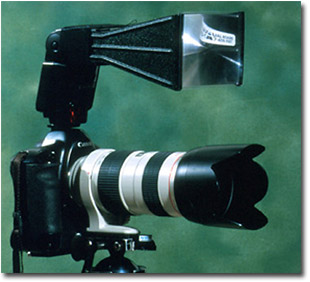 Most flash setups benefit by using more than one flash, but doing a multiple flash setup might be a bit tight if your flashes have to be within 16 inches of your subject as they would in the example given above. With hummingbirds, for example, that doesnít give the bird a great deal of room to fly around in or space for you to position your lens. Fortunately there are a few ways to obtain greater flash working distances.
Most flash setups benefit by using more than one flash, but doing a multiple flash setup might be a bit tight if your flashes have to be within 16 inches of your subject as they would in the example given above. With hummingbirds, for example, that doesnít give the bird a great deal of room to fly around in or space for you to position your lens. Fortunately there are a few ways to obtain greater flash working distances.
The easiest solution is to use a tele-flash extender. These tele-flash extenders are Fresnel lens attachments that mount in front of the flash head and direct the projected light from the flash into a more concentrated area. Over the years several have been Ďinventedí or marketed, beginning with Jack Wilburnís Natureís Reflections metal monster that worked wonderfully, but was ponderous to carry, and progressing today to the easy to carry and very efficient system produced by Walt Anderson, the Visual Echoís tele-flash, sometimes called a Better Beamer.
With the Visual Echoes tele-flash, my GNs basically double. For example, at 1/4 power, the GN of my 550EX is 40, but increases to 80 with the flash extender, at 1/8th power, the GN increases from 28 to 56; at 1/16th power from 20 to 40; and at 1/32nd power from 14 to 28. This increase in GN allows you to increase the flash to subject distances for any given f-stop.
For all of my tele-flash work, I now use the Visual Echoes tele-flash. With it, Iím assured of approximately a two-stop increase in my flash power, or a doubling of the Guide Number. Remember, when doubling the GN from 40 to 80, for example, the aperture increases by two stops at any given distance. At ten feet, for example, the aperture changes from f4 to f8, two stops of light, when I increase my GN from 40 to 80.
With a tele-flash attached to my 550EX flash, I can now be 3.6í away from my subject when using f22 (GN/f-stop = distance, or 80/22 = 3.6 feet). Thatís a workable distance for hummingbirds, providing enough space for a bird to fly in and enough room for me to position my lens and any flower props that I wish to add.
Tele-flash work needs to be fairly precise, however, since the flashís beam is concentrated into a smaller area. It is possible that you could position the flash incorrectly and actually miss the subject. Also, effective high speed flash work generally requires more than one flash in order to obtain a natural look, so youíll need to have a flash extender for each flash unit. Of course, you could compromise by placing one or more units closer than the flash or flashes with the tele-flash extenders attached, but you may end up with the same positioning and placement problems.
It is extremely important to know that you cannot use different power ratios to achieve the correct light balance if youíre trying to capture high-speed action. With different power ratios youíll get different flash durations, which results in a ghosting effect as the faster flash speeds Ďfreezeí one instant of the movement while the slower flash speeds capture or Ďfreezeí a longer period of time. Essentially youíll be recording two or even three different lengths of motion as each flash, set at a different power ratio, records the exposure over a different time interval. You want just one perfectly frozen image, captured by all of the flashes firing at the same time with the same flash duration.
Thereís another alternative, and thatís using specially built high-speed flash units designed for this purpose. Custom units feature a fast flash duration and a high GN, truly the best of both worlds. For many years the only custom unit readily available was one produced by A. Kenneth Olson of Minnesota. Ken produced two units Ė a standard and an ultra that
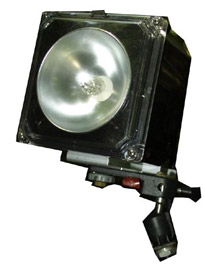 featured two power settings for each flash. The standard unit had a flash duration of around 1/18,000th at full power and 1/25,000th at half power. The Ultra had specs of 1/25,000th and 1/35,000th at full and half power, respectively.
featured two power settings for each flash. The standard unit had a flash duration of around 1/18,000th at full power and 1/25,000th at half power. The Ultra had specs of 1/25,000th and 1/35,000th at full and half power, respectively.
Unfortunately, Ken has passed away and his units, while still available second-hand, are difficult to find and even more difficult to repair should problems arise. Although I own three Olson units, Iíve used them very sparingly over the last few years as I worried that if they broke, my high-speed flash work was finished. Accordingly, I only used the Olsonís on special projects, and I worried what Iíd ever do when these flashes finally expired.
I no longer have that worry. Thereís a new high-speed flash system available, called the Stoplight flash, produced by Roy Dunn of Fotronixís in North Carolina (www.fotronix.com). There are several models of Fotronix flash in development, and I was fortunate to field test the SL-80.
The Stoplight 80 has a Guide Number of 85 and a flash duration of 1/12,000th sec. Compare that with my 550EX flash, which has a GN of 28 for 1/8th power and a possible 1/8,000th second, and a GN of 20 at 1/16th power and a possible duration between 1/12,000th and 1/15,000th second. Keep in mind that I canít give the exact flash durations because Canon doesnít supply that data. Alternatively, I can use a Stoplight 80 flash with a GN of 85 at 3.8 feet at f22, with a known and very fast flash duration of 1/12,000th sec.
The Stoplight flashes have several features especially attractive to wildlife photographers. Number one, perhaps, is that the flashes are extremely water resistant. They are not waterproof, which would imply that they could be used underwater, which they cannot, but they can be safely used in a rain. That means these flashes can be left out, on station or at a set, regardless of weather, although to be prudent I cover mine with plastic when theyíre not in use.
The flash duration of 1/12,000th sec. is fast enough to freeze any wildlife subject Iím after, including most flying insects, and the recycle time between flashes is less than one second. In our field tests the flashes kept up with my shooting when I shot on single frame as fast as that drive allowed.
Just as important as any other feature, the Stoplights are safe. One major criticism of the Olson units was the potential health hazard they represented. The voltage for the Olsen flash was stored in the flash capacitors in a separate console where powerful and potentially lethal voltage passed to the flash heads via a flash cable. Should the cable crack, the cable would no longer be insulated and a shock could occur. The Stoplight units are completely safe, with the voltage stored in the flash head itself, which is completely self-contained.
Regardless of the high-speed flash system you use, one flash aimed directly at the subject will produce the least satisfactory lighting effect. Your images will look more natural if the light is diffused, or if you use several flashes together. For most of my flash setups Iíll direct two flashes on the subject, sometimes in a key-fill arrangement and sometimes with both flashes placed at an equal distance to provide even illumination for a key-key effect. Iíll position a third flash to backlight the subject and aim a fourth at a background when appropriate to produce a lighter, more natural looking
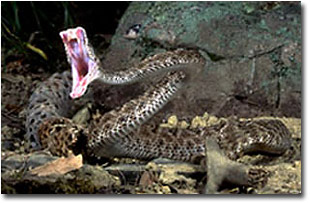 background. If Iím photographing a jumping frog or a flying bat or gliding flying squirrel Ė animals that are active at night, a dark background appears natural and I can eliminate the background light. If Iím shooting a diurnal subject, be that a hummer, a flying bluebird, a flying mantid or wasp, or a leaping diurnal gecko, then Iíll direct a fourth flash onto the background so that my subject is set off against a natural looking, illuminated background, instead of one that is black.
background. If Iím photographing a jumping frog or a flying bat or gliding flying squirrel Ė animals that are active at night, a dark background appears natural and I can eliminate the background light. If Iím shooting a diurnal subject, be that a hummer, a flying bluebird, a flying mantid or wasp, or a leaping diurnal gecko, then Iíll direct a fourth flash onto the background so that my subject is set off against a natural looking, illuminated background, instead of one that is black.
Exact lighting setups vary, of course, but I can make a basic setup within minutes, using the Inverse Square Law and my Minolta Flash Meter IVF to determine my lighting ratios and the aperture Iíll use. And by using flash, Iíve been able to capture actions and behaviors Iíve only dreamt about Ė striking rattlesnakes, basilisks running across water, insects and bats in flight, and more. With high-speed flash, I feel my photography is only limited by my imagination, and the amount of time I can devote to this fascinating tool.
Joe and Mary Ann - NPN 020
www.hoothollow.com
Comments on NPN high speed flash photography articles? Send them to the editor.
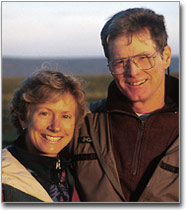 Joe and Mary Ann McDonald conduct photo and digital workshops at their home in Hoot Hollow, Pa., and lead photo tours and safaris around the world. Joe is the author of 6 books on wildlife photography and 1 on African wildlife; Mary is the author of 29 childrenís books on natural history. Joe is a columnist for Outdoor Photographer Magazine, and Joe and Mary are columnists for photosafaris.com and Keystone Outdoors, and field correspondents for Natureís Best Magazine.
Joe and Mary Ann McDonald conduct photo and digital workshops at their home in Hoot Hollow, Pa., and lead photo tours and safaris around the world. Joe is the author of 6 books on wildlife photography and 1 on African wildlife; Mary is the author of 29 childrenís books on natural history. Joe is a columnist for Outdoor Photographer Magazine, and Joe and Mary are columnists for photosafaris.com and Keystone Outdoors, and field correspondents for Natureís Best Magazine.
Joe has been a full-time nature photographer since 1983, and Mary since 1989. They have led photo safaris to all seven continents, and spend as much as 20 weeks per year in Africa. Their work has appeared in every major natural history publication in North America. Joe is an active member of the Outdoor Writerís Association of America and a former board member of the North American Nature Photography Association. Mary is a first place winner in the BBC/BG and Natureís Best photo competitions.
Joe and Mary maintain an active website that offers many features, including tips and questions of the month, a viewerís gallery, product reviews and links, and trip reports and portfolios. Complete photo and digital course and photo tour descriptions are available on their website, www.hoothollow.com.


| 


